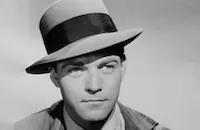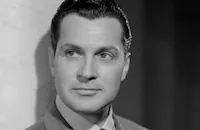The Daltons Ride Again
Cast & Crew
Ray Taylor
Alan Curtis
Lon Chaney [jr.]
Kent Taylor
Noah Beery Jr.
Martha O'driscoll
Film Details
Technical Specs

Synopsis
After being found guilty of bank robbery, Emmett Dalton, the head and last survivor of the notorious Dalton gang, relates the story of the fall of his family: The four brothers--Emmett, Grat, Bob and Ben--decide to give up their outlaw ways and escape to Argentina. Along the way, they stop in the Kansas town of Skeleton Creek to visit an old friend of their father, cattle rancher Tex Walters. Emmett soon falls for Mary Bohannon, the daughter of Skeleton Creek's newspaper publisher, Michael Bohannon. The brothers' plan to leave town is squelched when Tex is murdered, his land burned and his cattle are run off. When A. J. Haines, the local banker, refuses to pick up the $4,600 note held on the Walters ranch by the Prairie Development Co., Bob goes to the bank and robs it of $5,000. Realizing the money is stolen, Kate Walters, Tex's widow, refuses it, so Ben goes directly to the land company and pays off the note. Emmett and Grat then break in and steal the money back. Later, Bob returns to the bank, gives back the stolen money and forces Haines to write a new note for the Walters ranch. Unfortunately for the brothers, J. K. McKenna, the town drunk, recognizes the Daltons from a wanted poster and informs the sheriff. Knowing a posse is looking for the brothers, Michael convinces the four to accept his dinner invitation, but the sheriff soon arrives at the Bohannon home and begins a search. With the help of McKenna, however, the brothers manage to escape detection. Learning Emmett's true identity, Mary begs the outlaw to turn himself in, offering to marry him upon his release from prison. Meanwhile, McKenna, who is actually one of the heads of Prairie Development, orders his men to begin a reign of terror against the ranches around Skeleton Creek, knowing the Dalton gang will be blamed. Having been holed up at the Walters ranch, the brothers are unaware of McKenna's deception, so they do not stop Emmett when he announces his intention to turn himself in. Mary then arrives at the ranch and tells the three remaining brothers that a $5,000 reward is being offered for any of the brothers, dead or alive. When Emmett is seen entering the sheriff's office, a lynch mob quickly forms, but his brothers arrive in town just in time to rescue him. After eluding the posse, the Daltons go to Michael to plead their innocence, noting that all the witnesses who identified them worked for the land company. Realizing that the land company is trying to force the ranchers off their lands in order to acquire a railroad right-of-way, the Daltons steal Prairie Development's land deeds and take them to Bohannon. McKenna, however, kills the newspaperman before he can print the story. The Daltons are blamed for the murder, with the land company offering to double the rewards against them, but during a town meeting, Jeff Coulton, Michael's assistant, accuses the land company of his boss's murder. The Daltons then arrive at the meeting with the stolen deeds, proving Prairie Development's complicity. McKenna tries to escape, but in the ensuing gunfight, he is shot by Emmett. While his brothers set off for Coffeyville, Emmett tries to turn himself in to the sheriff, but upon learning that his brothers are headed into a trap, he instead races to Coffeyville. He arrives just in time to be shot as his brothers try to rob the First National Bank and are killed. Despite his confession, Emmett is given a life sentence for his many crimes, but Mary promises to wait for him and pray for his parole.

Director
Ray Taylor
Cast

Alan Curtis

Lon Chaney [jr.]

Kent Taylor
Noah Beery Jr.

Martha O'driscoll
Jess Barker

Thomas Gomez

John Litel

Milburn Stone

Walter Sande

Douglass Dumbrille
Virginia Brissac
Stanley Andrews

Fern Emmett
Charles Miller
Cyril Delevanti
Frank Dae
Tom Quinn
Wheaton Chambers
Geoffrey Ingham
Paul Scardon
Ruth Lee
Davison Clark
Jack Rockwell

Bob Wilke
Roy Butler
Dick Dickinson
George Chesebro
Bill Sundholm
Jackson Shadle
Dick Alexander
Charles Mcavoy
Henry Hall
Ethan Laidlaw
Ed Cassidy
Sid Troy
Al Choals
Jack Worth
Paul Smith
Nick Warick
Monte Montague
Crew
Henry Blankfort
Bernard B. Brown
Roy Chanslor
Paul Gangelin
Russell A. Gausman
John B. Goodman
Willard Holland
Paul Landres
Arthur D. Leddy
Harold H. Macarthur
Jess Moulin
Jack P. Pierce
Ronald K. Pierce
Frank Skinner
Harold I. Smith
William Tummel
Charles Van Enger
Howard Welsch
Vera West

Film Details
Technical Specs

Quotes
Trivia
Notes
According to Hollywood Reporter, this film was originally scheduled to be developed, produced and directed by Ford Beebe, but there is no indication that he had any involvement in the released film. The Dalton Brothers gang, which operated in Kansas and Oklahoma, comprised Grattan Dalton (1865-1892), Robert Dalton (1870-1892), Emmett Dalton (1871-1937) and Bill Doolin (1858-1896). After first serving as peace officers, the Dalton brothers turned to a life of crime, starting as horse thieves. In 1892, they graduated to holding up trains and banks, and by the end of the year, they planned a double bank raid in Coffeyville, Kansas. Authorities anticipated their arrival, however, and opened fire on them. As depicted in the film, Grat and Bob were killed and Emmett was captured and imprisoned. Doolin did not participate in the raid, and later, a fourth Dalton brother, Bill (1866-1895), also became an outlaw, joining Doolin's newly formed gang. Three years later, Bill was shot by a posse while hiding in his home.
Upon his release from prison in 1907, Emmett started a crusade for penal reform and dabbled in motion picture making and writing. Emmett's first film, a short titled The Last Stand of the Daltons, was released in 1912 and was advertised as a realistic portrayal of the Old West. [According to modern sources, a fake version of the short appeared in theaters in 1914.] In 1918, Emmett's 1916 novel Beyond the Law was made into a six-reel film of the same name and was produced by his company, Southern Feature Film Corp. (see AFI Catalog of Feature Films, 1911-20; F1.0317). In that film, which was directed by Theodore Marston, Emmett portrays not only himself, but brothers Bob and Frank (the eldest Dalton) as well. Many other films based on the lives of the Dalton brothers, or featuring them as characters, have been produced. In 1940, Universal made When the Daltons Rode, directed by George Marshall and starring Randolph Scott and Kay Francis (see AFI Catalog of Feature Films, 1931-40; F3.5051). Some contemporary reviewers referred to The Daltons Ride Again as a sequel to When the Daltons Rode. In 1957, United Artists released The Dalton Girls, directed by Reginald LeBorg and starring Merry Anders and Penny Edwards.












